Through games of Feb. 15, Giannis Antetokounmpo was the 3rd best player in the NBA behind only James Harden and Anthony Davis, according to Basketball Impact and Efficiency (BIER) positional ratings. Lebron James and Steph Curry rounded out the Top 5.
No one should be shocked and awed by these revelations, as the top spots in the BIER Rankings merely confirm what you and me and even casual NBA fans already know, while also confirming that BIER’s a reliable box score stats model that works. (For an explanation of BIER go to the BIER Basics page, wherein the thorny question of whether or not the world really needs another advanced box score metric is also addressed, formula included).
Here’s the entire BIER Top 20 at the All-Star break (through games of Feb. 15):

The All-Star break made for a good stopping point for the compiling of things, so I found some time to crunch the 2017-18 season BIER numbers for every NBA player, then created a relative scoring system by position to rank the top 60-70 players (expressed as “median +”). For example: Giannis has a BIER rating of 15.91, which is 10.24 above the median (5.67) for all power forwards. James Harden‘s rating is actually lower (due to missed shot volume and turnovers) but because the median for shooting guards this season is 3.005, he comes out on top in this “relative” ranking system at 11.52.
The non-centers in the first 16 are another affirmation that this BIER thing is no crackpot system — from Harden to Irving, the fans, players and coaches got the easy 12 All-Stars right, noting that Chris Paul didn’t make the mid-season party due to missed games (injury) earlier in the season.
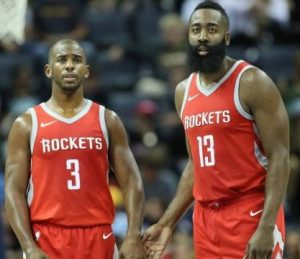
Chris Paul (left) and James Harden have their sights set on the Warriors’ Western Conference title and a shot at winning it all this season in Houston. USA Today Sports photo. License: Standard non-commercial use.
-
James Harden will, in all likelihood, win the MVP this year and deserve it. A 14.53 BIER for a shooting guard is the territory of Michael Jordan, the only SG in history to record a career BIER greater than 14. That Harden doesn’t shoot as efficiently as Jordan hardly matters when the Beard is doing so much of everything else in the box score, and the Rockets have won 17 straight. Harden’s 38% from three is the best he’s shot it since his 2012, his last year in OKC.
2. Anthony Davis edges out Antetokounmpo with better free throw shooting, offensive rebounding, blocked shots (leads the NBA) fewer turnovers (the Brow doesn’t play point forward) and fewer fouls. Since I crunched these numbers, the Pelicans have won 7 straight and Davis has gone for 40+ points in three of the wins. Giannis and the Bucks have won 2, lost 6, and fallen to 8th in the East, though Giannis has been good enough to stay in the league’s top 5 or 6 rated players.
4. Lebron James, at age 33, is averaging 26 pts, 9 boards and 8 assists per game, feats that a 33-year-old Larry Bird nearly matched (24.3 pts – 9.5 rebs – 7.5 assists) — and Lebron is showing no signs of slowing down. The Oscar Robertson for modern times, however, turns it over a lot (4.3 per 36 – BIER is a per minute, pace adjusted model) and doesn’t rebound like the Brow or the Greek Freak. Those factors tend to offset his greater assist rate in the BIER rating. All three forwards were shooting 54% from the field at the break.
5. Steph Curry laid a little low last season as he worked to integrate Kevin Durant into the Warriors offense, but Steph’s back to MVP form this season, shooting just one FG% point shy of the 50-40-90 Club — and how does he manage nearly 6 boards a game?
6. In Houston, Chris Paul has quietly gone about his business (except for that craziness with in the Clippers locker room), and the business of Chris Paul is to file top 5 All-Time BIER point guard numbers. CP3 is right there with John Stockton at No. 2 behind Magic Johnson, which means that Curry isn’t far behind on the All-Time list.
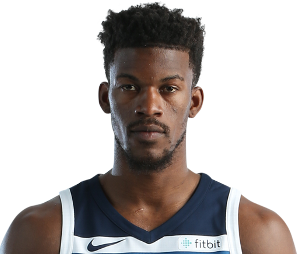
“Seventh? That can’t be right.” Jimmy Butler‘s having another great season, reunited with coach Thibs. T-wolves photo. License: Standard non-commercial use.
7. Jimmy Butler‘s career NBA offensive rating is 10th All-Time (118.85/100), believe it or not, and 3rd among active players (behind Paul and DeAndre Jordan).
8. Kevin Durant is shooting 43% from three, but he’s a bit off this season — his true shooting percentage is down .04 points, from 65.1% to 64.7%. The numbers being filed by these top 9 players are unreal.
(9. Russell Westbrook gets a full discussion in the “BIER Basics” post).
10. Rockets center Clint Capela represents part of the Frankenstein model for centers in the new NBA — “Frankenstein” because no player possesses all the many attributes found in the crop of young centers. Capela is quick, athletic, mobile enough to guard the 3-point line, a shot-blocker, rebounder and dunker of many lob passes — which means he doesn’t miss many shots. BIER loves that. Basketball-reference had a stat the other day about how Capela this season will become the youngest player in NBA history (age 23) to record a double-double season while shooting 65% or better. He also blocks 2.4 shots/36, 3rd among qualifying centers. (Capela also represents the part of the new NBA center model where the center doesn’t play full-time minutes, though he does qualify to be ranked here. The minimum qualification for BIER ranking is playing time of 25 mins per game, with a case-by-case minimum on number of games due to the crazy number of star players getting hurt this season).
11. Thought the Knicks most impactful player was Kristaps Porzingis? Nope, that guy is Enes Kanter, who’s been a high-efficiency brawler in the offensive paint in New York (his 5 OREBs per 36 is 3rd among NBA centers). Porzingis, despite the NY media glow and All-Star politics, won’t make the lists here, which should tell you there was a reason the Knicks weren’t winning before “the Unicorn” had season-ending knee surgery.

2017-18 has been Damien Lillard’s finest season, according to BIER. NBA.com photo. License: Standard non-commercial use.
12-13. But let’s talk about the players who are on the list, like Damian Lillard, on fire of late and having his best season as a pro in Portland, according to BIER; and Victor Oladipo, having a breakout year leading the NBA in steals and the Pacers into the hunt for top-4 playoff seeding in the East.
14. Pistons center Andre Drummond edges out Hassan Whiteside of the Heat, and it’s not all about offensive rebounding, though Drummond leads the league on the O-glass and overall rebounding; it’s also about Drummond’s better passing and his theft rate. Drummond leads all qualifying centers in steals per 36 mins (1.7) and his assist rate is double the median for centers. So despite not having quickness, mobility or great shot-blocking ability (like Capela), Drummond has an all-around floor game that any box score-based stat model would love.
15. Whiteside is all of the above as an imposing defender and rebounder but doesn’t have all-around offensive skills like some “new centers.” Based on Miami’s winning ways in January, Whiteside probably would have been an All-Star had he not missed 18 games earlier this season, though who knows — the East coaches might’ve snubbed Whiteside too, as they did with Drummond in the first-seven reserves voting. Heat point guard Goran Dragic was selected.
16. Surprised that Kyrie Irving — who’s flirting with 50-40-90 Club shooting season and would be the 8th player in history to join that club — isn’t ranked higher? Irving has thrived in Boston, but it’s not as though he’s transformed into a wholly different player. Other point guards, even Lillard, pass the ball more, as Irving’s assist rate is about the league median for PGs (5.5 per 36). Irving this season is well ahead (at 10.17) of his career BIER rate (8.49).
17. DeAndre Jordan, in his 10th season Clippers, may not have the quickness to defend the perimeter (again, like Capela) but he can dunk a lob pass like nobody’s business. 10 years in Lob City have put Jordan on the Top 20 All-TIme BIER center lists, and he’s quietly had another great year as L.A. battles down the stretch for a playoff spot. The rebounding numbers for Jordan, Drummond and Whiteside are off the charts – all three centers board at nearly 17 rebs per 36. Ridiculous, but also a reflection of the all-time low offensive rebounding rates in the NBA this season. Crashing the offensive glass is a feature of bygone days in the NBA, which has made defensive rebounding a lot less like work for the better big men.
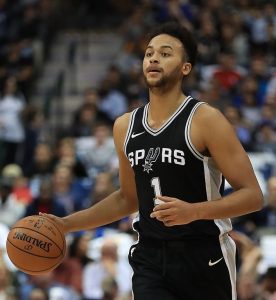
Is it the player or the system? Whichever it is, Kyle Anderson of the Spurs made the BIER Top 20 at the All-Star break. Photo by Ronald Martinez, Getty Images. License: Standard non-commercial use.
18. Who is Kyle Anderson? He’s the 24-year-old forward for the Spurs who’s been starting in place of injured Kawhi Leonard (shoulder). Anderson doesn’t shoot a lot (8 times per 36 mins) but hits a high percentage (51%), and rebounds the small forward position like it was the 1980s (7.5 per 36), while dishing out 3.6 assists and coming up with 1.8 steals/36 (2nd among SFs). He’s filling up the box score without turning it over or fouling a lot — all of which has him in the Top 20, sneaking in just above the 25 minutes per game requirement. But there’s always the nagging question for the Spurs’ small forward — is it the player or the Popovich system?
19. Otto Porter is a super-efficient shooter at forward (49-40-84%) and one of the reasons the Wizards kept winning when John Wall went down with a knee injury at the end of January. In his 5th season, Porter’s a strong wing defender who rebounds his position (7.3 per 36) and has the 3rd-best SF steal rate (1.8/36). In the Wizards recent win in Milwaukee, Porter stole the ball three times while turning it over 0 times. The 0 turnovers were no happy accident — he rarely turns it over, just once per 36 mins while playing catch-and-shoot with the Wizards All-Star guards. Porter is averaging a career best 15.1 pts per game this season.
20. Karl-Anthony Towns is one of the few centers in the league actually making a high enough % of his 3-point attempts to be out there shooting them. Towns was shooting 55-42-86% on FGs-3pt-FTs at the All-Star break and his numbers have actually improved slightly since then. No center in the history of the NBA has shot the ball from the outside as well as Towns, who is only going to get better.
That’s the Top 20, and here’s the next 20, where the BIER calculation didn’t fail to produce some surprises.


Orlando traded Elfrid Payton to Phoenix for a 2nd round pick, even though he’d found ways to minimize his poor outside shooting while maximizing the rest of his game. Photo by Zimbio. License: Standard non-commercial use.
23, 31. Elfrid Payton and Rondae Hollis-Jefferson ahead of All-Stars like Paul George, Bradley Beal and Kemba Walker? They play NBA games in Orlando and Brooklyn, and there are some young players on those teams filling up box scores and finding their games. The BIER formula does what it does.
Payton was easily the biggest surprise for me. The Magic traded him to the Suns last month for a 2nd round pick, so I wasn’t at all expecting him to show up here. The problem with Payton (all pause to marvel the work of his hair stylist) is that he can’t shoot. But unlike a lot of guys who can’t shoot in the NBA, Payton has figured out how avoid throwing up bad shots. He shoots 50%, has made 35% of his threes this season, and — as a taller point guard — has high rebound and assist rates. Orlando just didn’t want to pay him this summer after his 4-year rookie contract expired, but Phoenix might be a good fit given the young guns on the Suns.
21. Steven Adams — the unsung hero on the Thunder — leads off “the next 20” rankings and is having a monster season for OKC. Adams’ OREB rate is 2nd only to Drummond among centers, and OKC leads the NBA in offensive rebounding (28.3% rate). Somebody’s gotta save all those possessions Westbrook, Paul George and Carmelo toss at the rim (there are a lot of those), and in steps Adams to clean it up. Adams is 3rd in the NBA at 4.6 2nd chance pts per game. Adams avgs. 14 pts and 9 rebs a game in a full time (32 mpg) role. (He also joins Antetokounmpo, Porter, Rudy Gobert and Oladipo as players from the much-maligned 2013 draft who have steadily improved to where, now in their 5th seasons, they’re bonafide players to be reckoned with in the league.)
22. BIER says Ben Simmons of the 76ers should win Rookie of the Year (and he probably will), averaging an all-around 16.9 pts – 8 rebs – 7.6 assists/36.
24. Darren Collison is having a break-out shooting season for the Pacers and is the 3rd point guard in the rankings flirting with a “50-40-90 Club” season. With Oladipo at No. 13 and Collison at No. 24, suddenly the Pacers have one of the most efficient and impactful backcourts in the league, so far rating better than Derozan-Lowry, Wall (injured)-Beal and Lillard-McCollum.
25-39. From there we see a string of All-Stars (eight in all) led by Demar Derozan (25), having another great season in Toronto, his running mate Kyle Lowry (27), and Kevin Love (28). I wouldn’t classify Love as a center, so I split the difference making him a half-center, half-power forward. This was probably not the thing to do, technically, as basketball-reference has Love playing center 98% of the time. But K-Love hasn’t changed his game with his new role — 40% of his shots were threes (before another injury sidelined him). I also split the difference with Draymond Green, who alternates between power forward and small forward with Kevin Durant (also spit). This was the right thing to do, technically. Few teams actually play “positionless basketball” but the Warriors forwards truly are interchangeable, with Green often playing point forward a la Lebron and Giannis.
29. Tyreke Evans in Memphis got back to the 20-5-5 numbers he put up when he beat out Steph Curry and Brandon Jennings for the 2010 Rookie of the Year award. Good numbers, though I can’t help but wonder if Evans will ever be able to put up those numbers for a team that wins games.
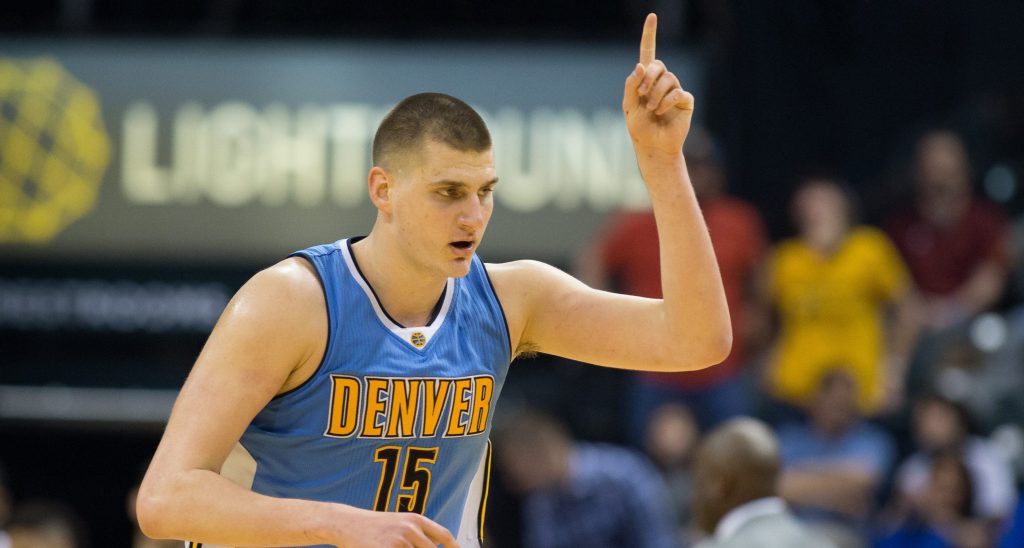
Nuggets center Nikola Jokic is No. 30 in the BIER rankings and joins the Clipper’s Lou Williams as the top Western Conference players snubbed in the 2018 All-Star selection. USA Today photo. License: Standard non-commercial use.
30. Nikola Jokic is another center to be reckoned within the new model, representing the 7-footers with mad guard skills. Jokic posted the fastest triple double in NBA history in Milwaukee just before the All-Star break and has all-around numbers at 16.9 ppg, 10.6 rebs and 5.9 assists per game. He’s also one of only a handful of qualifying centers shooting in the neighborhood of the NBA avg. of 36.1% behind the arc. The Joker was shooting 36.3% at the break. Al Horford, Towns, Love and Pau Gasol are the others, a list of 5 that looks a bit too forward-ish to really reflect a “centers shooting threes” trend, if making the 3-pointers has anything to do with it. (This is a topic begging for a separate blog). Jokic this season joined Lou Williams on the Western Conference All-Star snubs team.
31. In Brooklyn, BIER finds a player in the rough in Rondae Hollis-Jefferson, a steadily improving 3rd year forward who, if he ever learns to shoot the three (he’s hitting just 26% this season), could develop into a star given the strengths in the rest of his game.
35. Paul George makes an appearance, and is Top 4 relative to other small forwards — and shooting 43% from three this season in addition to being one of the best defenders in the league. He was the 8th reserve All-Star selected by the West coaches, which BIER confirms was a fair choice. Never has a borderline All-Star received as much media attention as George does, however, and I think nearly every NBA analyst who’s seen Lou Williams (26) play lately has said that “Lou Williams should have been an All-Star”. BIER also confirms this, and Lou’s ahead of George at No. 26 in the BIER ranking.
Two “dinosaurs”: Is Toronto center Jonas Valanciunas really shooting 44.6% from three and why is he on this list? Well, he’s not on the list really, and he’s taking fewer than one 3-pointer a game, so he’s not really on that list either, nor his he playing the minimum of 25 mins per game. I included both Valanciunas and Boston’s Greg Monroe (who also hasn’t qualified) because they have so much in common as so-called “dinosaur” centers — and their BIER numbers are so nearly identical — that it’s just interesting to have in the chart. At the end of the day, Valanciunas and Monroe are more efficient scorers and better rebounders than the vast majority of centers in the league; and when they’re in the game, they contribute big impact numbers despite their teams preferring to play outside-in.
40. Jrue Holiday closes out the Top 40, which makes a lot of sense in light of Holiday finding a next level to his game in New Orleans playing with Rajon Rondo and Anthony Davis in the absence of injured DeMarcus Cousins. Holiday’s averaged 21.7 pts and 7.6 assists since Cousins season ended Jan. 26, and he’s raised his 3-point shooting to 35% on the season.
Where oh where, Boozy Bango the Bucks fan wants to know, are Eric Bledsoe and Khris Middleton? They appear in the next 20, with Bledsoe ranked No. 49 and Middleton at No. 58, which seems to point to where the Bucks are at — struggling to beat other playoff teams, falling to 8th in East, losing three out of 4 to the Pacers and all three of their scheduled games to the Heat. Not that Top 50 for Bledsoe isn’t good, or that No. 58 is a dishonor for Middleton — All-Stars Al Horford (53), John Wall (55) and Klay Thompson (56) populate the 41-60 rankings. It’s just that Horford, Wall and Thompson probably shouldn’t have been named All-Stars this season either, according to BIER — and the Bucks have not been quite good enough. Here’s the the next 22:



















 Ray in Miami: There’s still mucho love for Ray Allen in Milwaukee, but they surely like him more in Miami these days. Ray’s staking his claim to “The Best Shooter in Basketball” crown,
Ray in Miami: There’s still mucho love for Ray Allen in Milwaukee, but they surely like him more in Miami these days. Ray’s staking his claim to “The Best Shooter in Basketball” crown,  Happy New Year! And welcome to 2012 on behalf of the editorial board at The Bob Boozer Jinx, most of whom are still sleeping off last night’s hilarity, events made possible by the board’s decision to handcuff me to the steering wheel of an alcohol-detecting cab and make me drive them around all night. They’re not responsible for any of the gunfire you might have heard at midnight.
Happy New Year! And welcome to 2012 on behalf of the editorial board at The Bob Boozer Jinx, most of whom are still sleeping off last night’s hilarity, events made possible by the board’s decision to handcuff me to the steering wheel of an alcohol-detecting cab and make me drive them around all night. They’re not responsible for any of the gunfire you might have heard at midnight. TEAM DEFENSE: The Bucks — so far — have maintained their 2011 Top 5 defense despite new additions Mike Dunleavy, Jr., and Beno Udrih, guys hardly known for tenacious D. Entering Sunday’s games, the Bucks ranked 2nd, giving up just 95.2 points per 100 possessions.
TEAM DEFENSE: The Bucks — so far — have maintained their 2011 Top 5 defense despite new additions Mike Dunleavy, Jr., and Beno Udrih, guys hardly known for tenacious D. Entering Sunday’s games, the Bucks ranked 2nd, giving up just 95.2 points per 100 possessions.  INDIVIDUALS: Five Bucks are on the NBA Top 20 lists, four of them for good stuff. The “bad” is Stephen Jackson, who ranks 16th in fouls. The four “good” are Andrew Bogut (no surprise there), Brandon Jennings (a bit of a surprise), Ersan Ilyasova (no surprise here at the Jinx) and Carlos Delfino (Del-3-no!). Lets begin with Bogut.
INDIVIDUALS: Five Bucks are on the NBA Top 20 lists, four of them for good stuff. The “bad” is Stephen Jackson, who ranks 16th in fouls. The four “good” are Andrew Bogut (no surprise there), Brandon Jennings (a bit of a surprise), Ersan Ilyasova (no surprise here at the Jinx) and Carlos Delfino (Del-3-no!). Lets begin with Bogut. BRANDON JENNINGS: The 7th leading scorer in the NBA at 22.7 per game, and doing it fairly efficiently. My computer froze when I wrote that the first time. BJ is shooting 46% from the floor and getting to the line in the 4th quarter when the Bucks need him to the most.
BRANDON JENNINGS: The 7th leading scorer in the NBA at 22.7 per game, and doing it fairly efficiently. My computer froze when I wrote that the first time. BJ is shooting 46% from the floor and getting to the line in the 4th quarter when the Bucks need him to the most.

 It’s really true
It’s really true Shaq’s rebellion won over many of us NBA fans in flyover midlands country, and as he turned his back on them, he nagged Kobe’s self-centered game, defying Jackson and Stern, foiling the L.A. dynasty. The championship he won in 2006 with Dwyane Wade and Alonzo Mourning stands as Shaq’s emphatic signature on a Hall of Fame career — four-time champion, MVP, good teammate, joker, prankster, plentiful tipper of bellhops, barmaids, waitresses and food delivery workers all over America
Shaq’s rebellion won over many of us NBA fans in flyover midlands country, and as he turned his back on them, he nagged Kobe’s self-centered game, defying Jackson and Stern, foiling the L.A. dynasty. The championship he won in 2006 with Dwyane Wade and Alonzo Mourning stands as Shaq’s emphatic signature on a Hall of Fame career — four-time champion, MVP, good teammate, joker, prankster, plentiful tipper of bellhops, barmaids, waitresses and food delivery workers all over America The year: 1994
The year: 1994 Beginning of the 3rd quarter, Game 5 in Chicago, Bulls with their season on the line down three games to one to the Heat, leading by seven points at halftime. …
Beginning of the 3rd quarter, Game 5 in Chicago, Bulls with their season on the line down three games to one to the Heat, leading by seven points at halftime. … What gives? Were these games against the Heat an aberration, a tough matchup (Bosh, Wade and Lebron) that belied Noah’s All-Defensive status?
What gives? Were these games against the Heat an aberration, a tough matchup (Bosh, Wade and Lebron) that belied Noah’s All-Defensive status?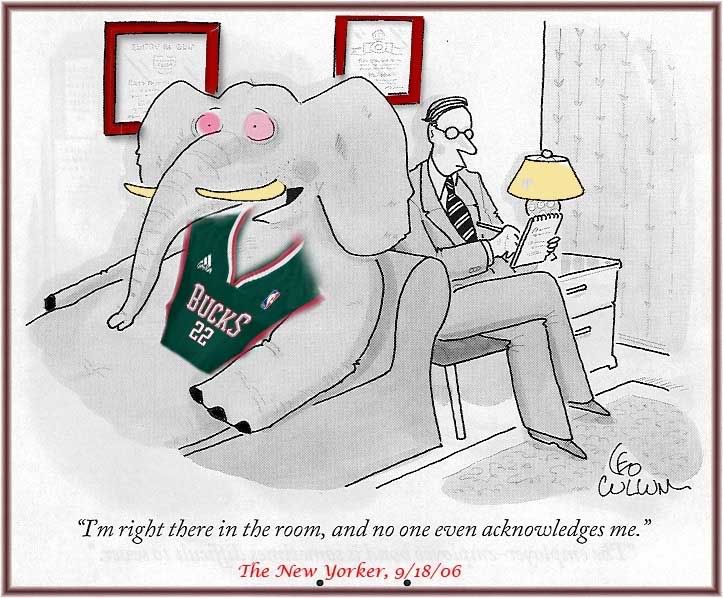 Michael Redd will return to the Bucks Monday, after All-Star weekend. By all accounts, he won’t play right away, but will work to get himself “in a position” where he could possibly play.
Michael Redd will return to the Bucks Monday, after All-Star weekend. By all accounts, he won’t play right away, but will work to get himself “in a position” where he could possibly play. I’m watching the Heat destroy the Knicks in New York in the second half and find myself feeling sorry for the Knicks. This game was tied at 59 in the 3rd quarter. A few minutes later it was a blowout as the Heat clamped down and the Knicks offered little more than token defensive resistance to Lebron, D-Wade, Bosh and Arroyo. Even Joel Anthony got into the act as the Heat outscored the Knicks 54-32 from the 3rd quarter tie on.
I’m watching the Heat destroy the Knicks in New York in the second half and find myself feeling sorry for the Knicks. This game was tied at 59 in the 3rd quarter. A few minutes later it was a blowout as the Heat clamped down and the Knicks offered little more than token defensive resistance to Lebron, D-Wade, Bosh and Arroyo. Even Joel Anthony got into the act as the Heat outscored the Knicks 54-32 from the 3rd quarter tie on.